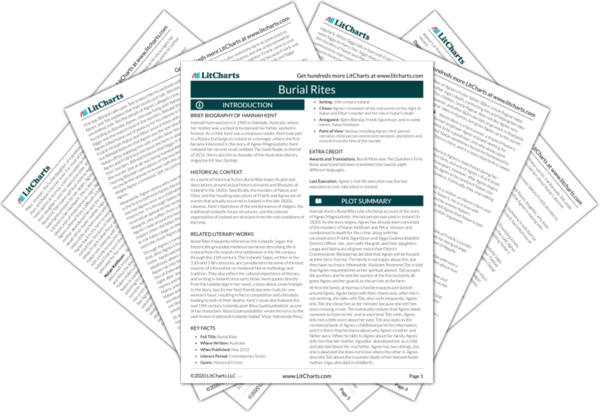Truth and Liberation
Burial Rites uses fiction to explore the reasons for and events surrounding the real murders of Natan Ketilsson and Pétur Jónsson in Iceland in 1828. In doing so, it engages with questions about God, meaning, and the power of truth. Characters in the book frequently discuss whether stories that they hear are “true,” as Iceland is very isolated and has a limited communication network, making news unreliable and rumors omnipresent. For example, Margrét’s neighbors…
read analysis of Truth and LiberationWomen, Violence, and Innocence
Throughout the book, the novel portrays many of the challenges faced by women in 19th-century Iceland, from the gender roles that restrict them to the challenges of childrearing and childbirth. Clearly, life for Kent’s characters is difficult, between the bad weather, the isolation, and the poverty. These difficulties, however, are exacerbated for women, whose role as child bearers can be dangerous in such extreme conditions. Kent describes in gruesome detail Agnes’s foster mother Inga…
read analysis of Women, Violence, and InnocenceLiteracy, Language, and the Icelandic Landscape
In Burial Rites, the special place of writing and language in Icelandic culture quickly becomes apparent as Kent tells Agnes’s story. Language and literacy are essential aspects of Icelandic cultural history, as Iceland has long had one of the highest rates of literacy in the world.
Icelanders in Kent’s book place high value on literary knowledge and writing ability, showing how they value not only literacy itself, but also the quality of the…
read analysis of Literacy, Language, and the Icelandic Landscape
Names, Superstition, and Christianity
Kent places special significance on the role of naming and how names reflect and inspire meaning. Names in Icelandic culture have different significance than names in most English-speaking cultures, and Kent even goes so far as to preface her novel with an explanation of the Icelandic naming system. The Icelandic naming system, unlike the Western European one, is patronymic, meaning that the last name of each person is taken from their father’s first name. Notably…
read analysis of Names, Superstition, and ChristianityClass, Colonization, and Hierarchies of Power
Hannah Kent’s story of Agnes Magnússdóttir is inextricable from the hierarchies of power that defined Icelandic politics and life in the early 19th century. At the time, Iceland was a colony of Denmark, meaning that Iceland had to defer to the Danish crown and follow Danish law. The colonial state of Iceland was thus already the manifestation of a hierarchy, but the state also created further inequalities within the island itself. Burial Rites clearly depicts…
read analysis of Class, Colonization, and Hierarchies of Power






